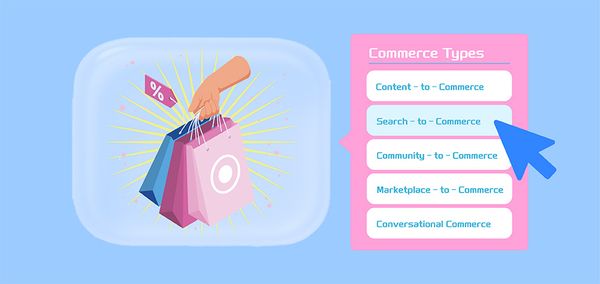What Is Omnichannel Retail and How Does It Work

Ever wondered how filling your online shopping cart and making a purchase has become so smooth these days? You can buy things online and then pick them up from a nearby store, or shop on your phone and all your choices are remembered. There are so many choices, all thanks to omnichannel retail.
If you are thinking about what is omnichannel retail then don’t worry! We have got it covered. In this blog, we will talk all about omnichannel retail, how it works, its benefits, and its examples. So, if you are ready to learn, let's jump in!
What Is Omnichannel Retailing
So, what exactly is omnichannel retailing? Well, it's a retail strategy that integrates the customer's shopping experience across multiple channels, be it online or offline. It makes sure to create a unified and consistent experience, no matter how, when, or where a customer decides to engage with a brand.
The term 'omnichannel' merges the Latin word 'omni', meaning 'all', with 'channel'. When we talk about retail, it points to a strategy where a customer can engage with a company's offerings through various connected channels. These channels could be physical stores, online sites (on a computer or mobile), phone sales, or any other way of selling.

|
Adapt Your Product Prices Automatically DSers Automatic Pricing - Pre-set Pricing Rule to mark-up your product price automatically |
But omnichannel retailing aims for more than just being present on all platforms. It's about ensuring that customers have a smooth and consistent journey when they move between channels. So, a customer could look at products online, check them out in a store, order them on a mobile app, and then choose home delivery or store pick-up.
The Importance of Omnichannel Retailing
Why is omnichannel retailing so crucial? Simple, it allows retailers to meet customers wherever they are, catering to their changing needs and preferences.
Indeed, one of the most compelling arguments for adopting omnichannel strategies comes from statistics around customer retention. A study found that companies with robust omnichannel customer engagement strategies retain an average of 89% of their customers.
In stark contrast, companies with weak omnichannel strategies manage to retain only 33% of their customers. This stark difference underscores the immense potential and impact of implementing a well-planned and executed omnichannel strategy for companies looking to bolster customer loyalty and retention.
The idea of omnichannel didn't appear out of nowhere. It grew over time from one channel to many channels and finally to omnichannel. This development shows how retailers continually change to enhance the shopping experience.
At its core, omnichannel retailing focuses on the customer. It aims to place customers at the heart of business strategy, understanding their shopping habits, likes, and needs. This way, businesses can offer personalized experiences, boost customer interaction, and increase customer loyalty, which can lead to more sales and higher profits.
Omnichannel retailing is pointing toward the future of retail. Here, the focus moves from product-first to customer-first strategies, and the line between online and offline shopping gets blurrier. It's all about providing a smooth and exceptional shopping experience, no matter where or how a customer chooses to shop.
How Does Omnichannel Retailing Work
Understanding the workings of omnichannel retailing can give us insight into how it provides a seamless and integrated shopping experience. Here's how it happens:
Integration Process
The initial step in implementing omnichannel retailing involves connecting all customer touchpoints seamlessly. This includes brick-and-mortar stores, e-commerce websites, mobile applications, and even social media platforms. Each of these channels must be connected and synchronized to provide a seamless customer experience.
This integration enables customers to engage with a brand across multiple channels within a single transaction. For example, customers can order a product online and conveniently collect it from a physical store, or they can explore products in-store and make a later purchase online.
Customer Experience
The primary objective of omnichannel retailing is to elevate customer satisfaction. With integrated channels, customers can choose their best method of interaction which will give them a personalized and easy customer experience.
For example, if a customer adds a product to their cart on a mobile app, they can view and purchase that product later on their desktop or even in-store. This makes the shopping process more convenient and customer-centric.
Data Analysis
In omnichannel retailing, data analysis plays a critical role. Retailers gather data from all customer interactions across channels to understand their behavior and preferences. This information helps in personalizing the customer experience and making informed business decisions.
For example, if data shows that a customer frequently purchases certain types of products, retailers can recommend similar products to them, thus making the shopping experience more personalized and efficient.
Technological Requirements
Omnichannel retailing requires robust technology infrastructure. This includes a responsive e-commerce platform, an efficient CRM (Customer Relationship Management) system, data analytics tools, and an effective inventory management system.
These technologies ensure that customer interactions are smoothly coordinated across channels, that customer data is efficiently managed, and that inventory levels are accurately tracked across all locations.
The workings of omnichannel retailing revolve around integrating all retail channels, focusing on enhancing the customer experience, utilizing data analysis, and leveraging appropriate technologies. These elements together provide the customer with a seamless, consistent, and personalized shopping experience, which is the essence of omnichannel retailing.
Benefits of Omnichannel Retailing
Omnichannel retailing isn't just about creating a better shopping experience. It offers an array of benefits that can significantly improve business performance. Let's delve into these benefits and see how they could change the game for retailers.
1. Increased Sales
Omnichannel retailing can lead to an increase in sales. By providing a smooth shopping experience across different channels, customers are more likely to purchase and spend more per transaction.
As per research conducted by the Harvard Business Review, customers engaging with retailers through multiple channels were found to spend on average 4% more in-store and 10% more online, compared to customers who shopped through a single channel.
2. Enhanced Customer Engagement
Omnichannel strategies greatly improve customer onboarding and engagement. They allow a brand to maintain a consistent presence across all channels, be it online, in-store, or mobile.
This omnipresence allows retailers to be where their customers are, providing them with a personalized and integrated experience, thereby driving customer loyalty and repeat business.
3. Better Inventory Management
Implementing omnichannel strategies can aid in more effective inventory management. It allows retailers to have real-time inventory updates, preventing scenarios like overstocking or understocking. With an integrated view of inventory, retailers can ensure products are always available when and where customers need them.
4. Improved Customer Service
With omnichannel retail, customer service also sees substantial improvements. Because customer data is integrated across channels, customer service representatives can easily access a customer's history and provide quicker, more personalized service.
5. Gather Valuable Customer Data
Omnichannel retail allows businesses to gather valuable customer data across all channels. This data provides insights into customer behavior, preferences, and shopping habits. This information can then be used to improve marketing strategies, tailor product offerings, and ultimately, enhance the overall customer experience.
6. Greater Customer Retention
Finally, omnichannel retail can lead to higher customer retention rates. Customers who enjoy a seamless and personalized shopping experience are more likely to return and stay loyal to a brand. According to a study by the Aberdeen Group, companies with strong omnichannel strategies retain an average of 89% of their customers, as compared to 33% for companies with weak omnichannel strategies.
Examples of Omnichannel In Retailing
To understand the practical implementation and impact of omnichannel retailing, let's explore some real-world examples:
Amazon
As one of the world's leading e-commerce companies, Amazon has also ventured into the physical retail space with the launch of Amazon Go, Amazon Fresh, and Amazon Books. These stores allow customers to use the Amazon app for a seamless shopping experience.
In Amazon Go stores, customers can walk in, pick up the items they want, and simply walk out without having to stand in line for payment. The purchases are automatically billed to their Amazon account.
Disney
Disney has mastered the art of omnichannel retailing by providing an enchanting and seamless experience across its various platforms. Their mobile-responsive website allows guests to book trips, explore parks, and even use an interactive map.
Once at the park, the 'My Disney Experience tool helps visitors find attractions, view wait times, and even order meals. The MagicBand program serves as a hotel room key, a photo storage device for any pictures taken with Disney characters, and a food ordering tool.
Starbucks
Starbucks offers one of the best examples of an effective omnichannel customer experience. Their reward program is fully integrated across multiple channels - in-store, website, and mobile app.
Customers can check and reload their card balance via their phone, website, in-store, or on the app. Any change to the card balance gets updated across all channels in real time.
Oasis
Oasis is a UK fashion brand that’s integrated its e-commerce site, mobile app, and brick-and-mortar stores into a comprehensive omnichannel solution. When you walk into one of their stores, you’ll find sales associates armed with iPads that are available to give you accurate and up-to-date product information.
If it turns out that your desired item isn’t available in-store, the staff can instantly place an online order for you to have the goods delivered to your home.
IKEA
IKEA has also adopted an omnichannel strategy, providing an integrated experience across its online and offline channels. Customers can browse products online, check the in-store availability, and then visit the store to make a purchase. IKEA also offers an augmented reality app, IKEA Place, that allows customers to see how a piece of furniture would look in their home before making a purchase.
These examples demonstrate how different companies, across various industries, use omnichannel strategies to enhance their customer experience. They show that when implemented effectively, omnichannel retailing can lead to increased customer satisfaction and loyalty, and ultimately, drive business growth.
Wrapping Up
Omnichannel retail, a groundbreaking approach, effectively blends the digital and physical retail worlds, offering an unmatched, seamless customer experience. It's a transformative strategy, fostering higher customer engagement, efficient inventory management, improved customer service, and heightened sales.
As businesses navigate a rapidly evolving retail landscape, embracing omnichannel strategies has become the need of the hour rather than an option. As customers or retailers, understanding this innovative approach equips us to better engage in a retail world that is increasingly customer-centric. Remember, in today's retail sphere, customers need a wholesome experience, and omnichannel retailing plays a great contributing factor to it!












 Company
Company
 Why Choose DSers
Why Choose DSers
 Blog
Blog
 Help Center
Help Center




 Live Chat
Live Chat